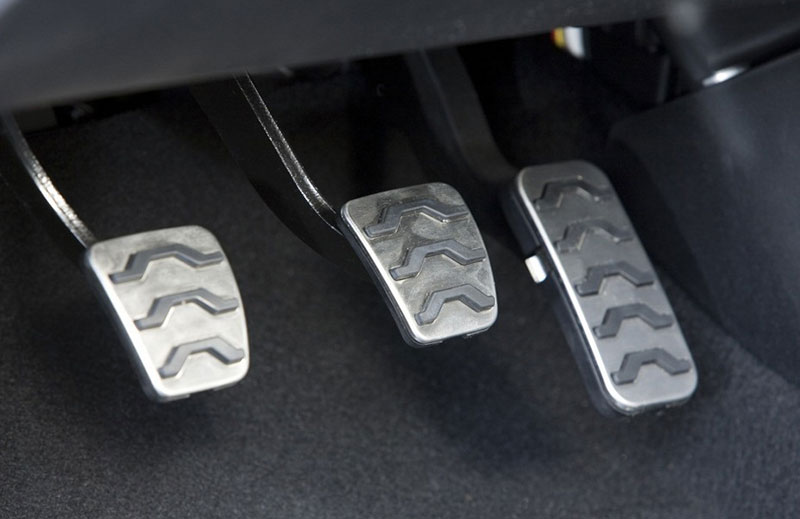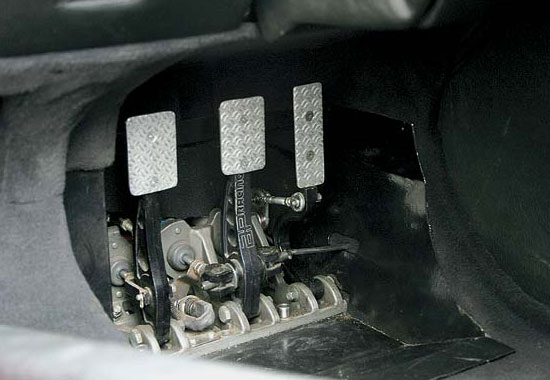
In every modern car there are several main controls - the steering wheel, pedals and gear lever. Pedals, as a rule, are combined into a special unit - a block of pedals. Read about the pedal unit, its purpose, types and design, as well as maintenance and repair in this article.
Purpose of the pedal unit
Even the creators of the first cars faced a serious problem: not all controls can be operated only with their hands, so pretty soon vehicles began to be equipped with pedals to control the legs. For quite a long time there was no single standard that would establish the location and purpose of the pedals, the schemes we are used to were more or less formed only by the 30s and 40s of the last century. And today we have three pedals on cars with manual transmission (gas, clutch and brake pedals), and two pedals on cars with automatic transmission (only gas and brake pedals).
Structurally, pedals are most often combined into a single structure - a pedal assembly or a pedal unit. This node solves several problems:
- Reduces labor intensity during installation and adjustment of pedals at the factory;
- Facilitates maintenance, repair and adjustment of pedals during maintenance and operation of the vehicle;
- Ensures the correct installation of the pedals and the correct operation of the drives of the mechanisms;
- Performs functions to improve the ergonomics and safety of the driver's seat.
Thus, the pedal assembly solves both purely technical problems and participates in the formation of an ergonomic workplace, thereby affecting the efficiency of the driver, his fatigue, etc.
Types and design of pedal blocks
Modern pedal assemblies can be divided into several groups according to applicability, completeness, functionality and design features.
According to applicability, all pedal blocks are divided into two large types:
- For cars with manual transmission (with manual transmission);
- For cars with automatic transmission (with automatic transmission).
The differences between the units for manual transmission and automatic transmission are in the different arrangement of pedals, their completeness, installation locations, etc. And in most cases, a pedal unit of one type is extremely difficult or even impossible to install on a car of another type.
In terms of completeness, pedal assemblies are divided into three main types:
- Pedal block for cars with automatic transmission, combining brake and gas pedals;
- Pedal block for cars with manual transmission, combining the gas, brake and clutch pedals;
- Pedal block for cars with manual transmission, combining only the clutch and brake pedals.
Thus, pedal blocks can combine all pedals, or only part of them. If the car uses a block of clutch and brake pedals, then the gas pedal is made in the form of a separate unit. Also, all pedals can be made in the form of separate nodes, but this solution is rarely used today.

In terms of functionality, pedal blocks are divided into three main groups:
- A block containing only pedals and components of the mechanical part of the drives of the corresponding systems - return springs, bipods, forks, connections, etc.;
- A unit containing both mechanical and hydraulic / pneumohydraulic parts of the corresponding systems - the brake master cylinder, brake booster and clutch master cylinder;
- A unit containing the electronic part of the systems, mainly limit switches, pedal sensors and others.
Finally, according to the design features, all pedal blocks can be divided (in some cases very conditionally) into two large groups:
- Frameless (frameless) pedal blocks;
- Blocks with a frame (frame) that holds all components assembled.
Using these types as an example, we will consider the main design features of pedal blocks.
Frameless blocks are arranged most simply. The basis of the assembly is the tubular axis of the clutch pedal, inside which the axis of the brake pedal is missed. At the end of the pipe and the axle there are levers (bipods) for connection with the drive of the corresponding system. Two brackets are used to mount the unit in the cab or interior of the car.
Blocks with a frame are more complex: the basis of the structure is a prefabricated steel frame that holds the pedals and other components. On the frame there are also brackets (or eyelets or just holes) for mounting the unit inside the cabin / cabin. The pedal axes, return springs, brake master cylinder with vacuum booster, clutch master cylinder and limit switches/sensors are fixed on the frame in one way or another.
The pedals themselves can be of two types:
-Compound;
- All-metal.
Components are made of several parts that allow you to adjust the length of the pedal or repair it without completely replacing the entire assembly. All-metal pedals are a single stamped, cast or welded structure that does not allow adjustments and changes the assembly in the event of a breakdown. The pedal pads are corrugated or covered with grooved rubber pads, which prevents the foot from slipping when driving.
Today, there is a wide variety of pedal blocks, but for the most part they have the design and functionality described above.
Maintenance and repair of pedal units
Pedal assemblies as such do not require special maintenance, but individual pedals of the unit may require attention within the framework of the maintenance of the system to which they belong. In particular, the adjustment of the clutch pedal and the cylinder associated with it is carried out during the maintenance of the clutch, the adjustment of the brake pedal and the brake cylinder - during the maintenance of the brake system, etc. Additionally, the pedals, their fasteners, spring tension and general condition can be checked at each TO-2.
In the event of malfunctions or deformations of the pedal, their deadjustment of freewheel and other problems, it is necessary to carry out repairs as soon as possible. With this work, you can not delay, since the handling and safety of the car depends on the functioning of the pedals. The procedure for maintenance and repair of pedals or pedal assemblies is described in the instructions for the corresponding cars, we will not consider them here.
With proper operation, timely maintenance and repair, the pedal unit will serve for a long time and reliably, ensuring the handling, comfort and safety of the vehicle.
Post time: Aug-24-2023
